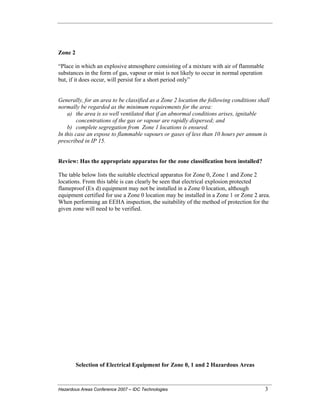All about Roar Solutions
All about Roar Solutions
Blog Article
The Single Strategy To Use For Roar Solutions
Table of ContentsThe Greatest Guide To Roar SolutionsNot known Incorrect Statements About Roar Solutions Roar Solutions Fundamentals Explained
In such an atmosphere a fire or surge is feasible when three standard conditions are satisfied. This is frequently described as the "hazardous area" or "burning" triangular. In order to shield installments from a possible surge an approach of analysing and classifying a potentially dangerous location is called for. The purpose of this is to make certain the correct choice and installment of devices to inevitably avoid a surge and to guarantee safety of life.
(https://dzone.com/users/5292804/roarsolutions.html)
No tools ought to be set up where the surface temperature of the devices is higher than the ignition temperature of the given hazard. Below are some common dirt harmful and their minimal ignition temperature. Coal Dust 380C 225C Polythene 420C (thaws) Methyl Cellulose 420C 320C Starch 460C 435C Flour 490C 340C Sugar 490C 460C Grain Dust 510C 300C Phenolic Material 530C > 450C Aluminium 590C > 450C PVC 700C > 450C Soot 810C 570C The likelihood of the risk being existing in a focus high adequate to create an ignition will certainly vary from place to place.
Dangerous location electric devices perhaps created for usage in greater ambient temperature levels. Field Repair By Authorised Personnel: Complex testing might not be required nevertheless certain treatments may need to be followed in order for the equipment to maintain its 3rd event score. Each item of equipment with a hazardous score need to be reviewed independently.
The 8-Minute Rule for Roar Solutions
The equipment register is a detailed database of tools documents that includes a minimum collection of areas to identify each item's area, technological specifications, Ex category, age, and environmental data. This info is vital for monitoring and taking care of the equipment successfully within dangerous areas. In contrast, for periodic or RBI tasting inspections, the quality will be a combination of Comprehensive and Close examinations. The ratio of Thorough to Shut inspections will be figured out by the Tools Danger, which is examined based on ignition threat (the likelihood of a resource of ignition versus the chance of a flammable atmosphere )and the hazardous location classification
( Zone 0, 1, or 2). This variant will certainly likewise affect the resourcing demands for work preparation. As soon as Great deals are specified, you can develop tasting plans based upon the sample dimension of each Lot, which describes the number of arbitrary tools items to be inspected. To identify the needed sample size, two facets require to be evaluated: the dimension of the Lot and the category of inspection, which shows the degree of effort that need to be applied( reduced, regular, or enhanced )to the assessment of the Whole lot. By integrating the category of assessment with the Whole lot size, you can then establish the ideal rejection requirements for a sample, suggesting the allowed number of faulty things discovered within that example. For more details on this procedure, please refer to the Energy Institute Guidelines. The IEC 60079 basic advises that the optimum interval between inspections ought to not exceed three years. EEHA examinations will certainly also be conducted outside of RBI campaigns as component of arranged upkeep and devices overhauls or repair work. These evaluations can be attributed toward the RBI sample dimensions within the impacted Whole lots. EEHA inspections are carried out to recognize faults in electrical devices. A heavy racking up system is vital, as a single piece of tools might have numerous faults, each with differing degrees of ignition danger. If the mixed score of both examinations is much less than two times the fault score, the Lot is regarded acceptable. If the Great deal is still considered unacceptable, it must undergo a full inspection or reason, which may set off more stringent examination protocols. Accepted Whole lot: The root causes of any type of mistakes are identified. If a common failing mode is located, additional tools might need maintenance. Faults are classified by severity( Safety and security, Integrity, Home cleaning ), ensuring that urgent concerns are analyzed and resolved immediately to reduce any kind of effect on safety or operations. The EEHA database need to track and tape the lifecycle of faults in addition to the corrective actions taken. Applying a robust Risk-Based Evaluation( RBI )approach is vital for making sure compliance and safety and security in taking care of Electric Devices in Hazardous Areas( EEHA) (eeha courses). Automated Mistake Scoring and Lifecycle Management: Easily take care of faults and track their lifecycle to improve evaluation accuracy. The introduction of this support for risk-based examination even more reinforces Inspectivity's placement as a best-in-class remedy for regulative compliance, along with for any asset-centric examination use case. If you have an interest in discovering more, we invite you to request a presentation and uncover exactly how our solution can change your EEHA management procedures.
Roar Solutions for Beginners

In regards to explosive danger, a dangerous area is an atmosphere in which an explosive atmosphere exists eeha (or might be anticipated to be present) in quantities that call for special safety measures for the construction, installment and use devices. hazardous area electrical course. In this short article we explore the obstacles faced in the workplace, the danger control steps, and the called for expertises to work safely
It is a consequence of modern life that we manufacture, save or manage a variety of gases or fluids that are deemed combustible, and a series of dusts that are regarded flammable. These compounds can, in particular problems, form eruptive ambiences and these can have significant and tragic consequences. Most of us recognize with the fire triangle remove any kind of one of the 3 components and the fire can not take place, yet what does this mean in the context of dangerous locations? When damaging this down right into its easiest terms it is basically: a combination of a specific amount of launch or leakage of a specific substance or material, blending with ambient oxygen, and the existence of a source of ignition.
In the majority of circumstances, we can do little concerning the levels of oxygen in the air, yet we can have substantial influence on resources of ignition, as an example electrical tools. Dangerous locations are recorded on the dangerous location category illustration and are recognized on-site by the triangular "EX-SPOUSE" indicator. Here, amongst various other key information, zones are split right into 3 types depending on the hazard, the chance and period that an explosive atmosphere will certainly exist; Zone 0 or 20 is considered one of the most hazardous and Area 2 or 22 is deemed the least.
Report this page